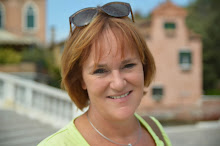You need:
- drawing sheet
- tempera paint in primary colors, black and white
- ruler
- pencil
- brushes
Show artworks from Ton Schulten and discuss them.
- Schulten's use of colors
- horizon line
- the 'curtains' on the sides - the picture is darker there than in the middle
- simple shapes
- divided in rectangles
You're going to draw a landscape like Ton Schulten. First draw a horizon line on about half of the sheet. Draw one or some simple houses. Then draw some draw trees. Divide the drawing with horizontal and vertical lines into small rectangles.
Paint the rectangles with tempera. Mix your own colors, starting with the brightest one. For example: start with white and add a drop of blue to get light blue; add more drops to get a darker blue.
Perhaps you can draw 'curtains', just like Ton Schulten: the sides are darker than those in the center.
Elements of art: shape, line, color, nuance.





